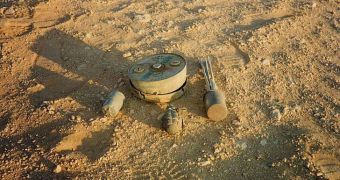Just yesterday, scientist Xiang Zhang with the University of California, Berkeley in the US and colleagues announced the development of a new sensor able to sniff out explosives with far greater precision than bomb-sniffing dogs or other gadgets and gizmos.
The sensor, described in a paper in the journal Nature Nanotechnology, is said to be so efficient that it can pick up airborne traces of explosives at concentrations well below one part per billion.
Looking to put things into perspective, the researchers who developed it explain that identifying concentrations of one part per billion is the equivalent of zoning in on a single blade of grass sitting on a football field.
Xiang Zhang and colleagues explain that, all things considered, this sensor could easily replace bomb-sniffing dogs. It would especially come in handy at airports and in regions where land mines are a threat to public safety, the scientists add.
Just for the record, it need be said that, according to figures released by the United Nations, land mines currently kill about 15,000 to 20,000 people annually. What's more, most of these people are women, children, and elderly.
Together with study co-author Ren-Min Ma with Peking University in China, specialist Xiang Zhang imagined the sensor being incorporated into a portable device that authorities and customs officials can carry around with them and use to locate explosives.
“Bomb-sniffing dogs are expensive to train, and they can become tired. The other thing we see at airports is the use of swabs to check for explosive residue, but those have relatively low-sensitivity and require physical contact.”
“Our technology could lead to a bomb-detecting chip for a hand-held device that can detect the tiny-trace vapor in the air of the explosive’s small molecules,” scientist Ren-Min Ma commented on the potential uses of this sensor.
The sensor comprises a layer of cadmium sulfate placed on top of a sheet of silver and a layer of magnesium fluoride that is nestled in between. It works by detecting the increased intensity in the light signal birthed by interactions between electron deficient explosives and the cadmium sulfate layer.
Experiments have shown that the sensor can detect traces of explosives like 2,4-dinitrotoluene (DNT), ammonium nitrate and nitrobenzene at concentrations of 0.67 parts per billion, 0.4 parts per billion and 7.2 parts per million, respectively.
Commenting on the sensor's efficiency, researcher Xiang Zhang wished to stress that “The ability to magnify such a small trace of an explosive to create a detectable signal is a major development in plasmonsensor technology, which is one of the most powerful tools we have today.”

 14 DAY TRIAL //
14 DAY TRIAL //